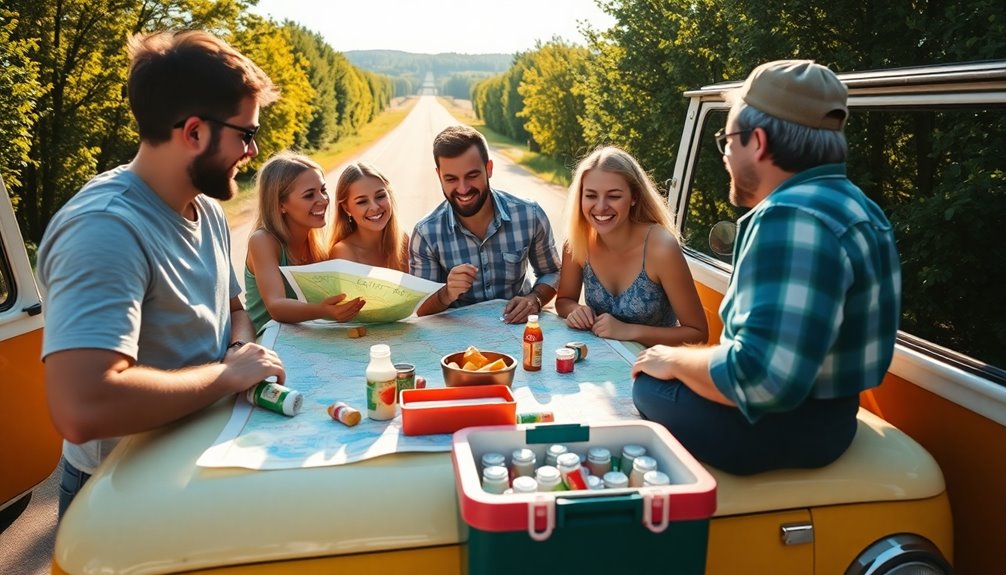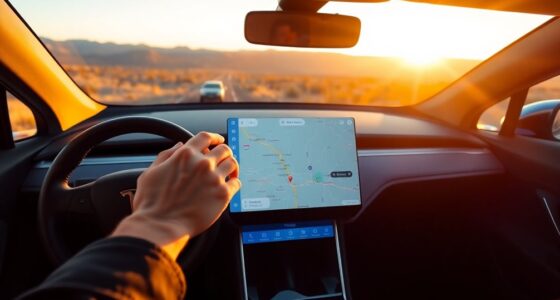To plan a budget-friendly road trip without sacrificing fun, start by setting a realistic budget that includes fuel, accommodations, and food. Look for economical spots to stay, like campgrounds or unique rentals. Pack smart by preparing meals and snacks in advance. Take advantage of free activities such as hiking and local festivals. Finally, maximize fuel efficiency with simple car maintenance and mindful driving habits. There's plenty more to discover to make your adventure unforgettable.
Key Takeaways
- Set a realistic budget by calculating fuel, accommodation, food costs, and a contingency fund for unexpected expenses.
- Look for economical accommodations like campgrounds, quirky motels, or unique Airbnb stays to save money.
- Pack smart by preparing budget-friendly meals and snacks to balance homemade food with occasional dining out.
- Explore free and low-cost activities such as national parks, local events, and scenic trails for enjoyable experiences without breaking the bank.
- Maximize fuel efficiency by maintaining your vehicle, checking tire pressure, and traveling light to save on gas costs.
Setting a Realistic Budget for Your Road Trip

When planning a road trip, starting with a realistic budget is crucial to guarantee you enjoy your journey without financial stress. It’s important to consider all potential expenses, such as fuel, accommodation, food, and activities along the way. To ensure you stay on track, consider following some road trip budget planning tips that can help you prioritize your spending and make the most of your adventure without overspending.
Begin by evaluating your current financial situation and determining a total budget limit. Next, calculate estimated fuel costs by mapping your route, checking your vehicle's miles per gallon, and multiplying the distance by average gas prices.
Factor in accommodation expenses by comparing prices for options like camping or budget hotels. Allocate a daily food budget by planning meals and packing snacks, balancing homemade meals with dining out.
Don't forget to include a contingency fund for unexpected expenses on the road, like tolls or parking fees. This way, you can stay within your budget while having a fantastic trip! Additionally, it's wise to set savings goals for your road trip to ensure you have enough funds for both planned and unplanned activities.
Finding Economical Accommodations

When planning your road trip, finding economical accommodations can make a big difference in your budget.
Consider options like campgrounds, quirky motels, or even unique stays on platforms like Airbnb.
With a little creativity, you can enjoy memorable experiences without breaking the bank. Additionally, exploring zoning laws can help you identify areas where tiny houses may be legally placed for an affordable stay.
Alternative Lodging Options
While traditional hotels can quickly drain your budget, exploring alternative lodging options can keep your wallet intact and enhance your road trip experience.
Consider car camping, which requires minimal gear and offers flexibility in choosing scenic spots. State and national park campgrounds are budget-friendly, typically costing $20-30 per night for up to six people.
You can also search for unique accommodations like glamping sites or retro-chic motels that provide charm without splurging. Platforms like Airbnb and Booking.com let you compare prices and find budget-friendly options, often with kitchens to save on meals.
For families or groups, multi-family cottages or group camping allow you to share resources, greatly reducing accommodation costs while creating lasting memories. Additionally, being prepared for unexpected situations can enhance your trip, ensuring you have the essentials for emergencies while exploring new places.
Campgrounds and Glamping Choices
Exploring campgrounds and glamping choices can make your budget-friendly road trip even more enjoyable.
State and national park campgrounds charge about $20-30 per night, accommodating up to six people, making them ideal budget-friendly lodging for families.
If you want comfort without the gear investment, glamping sites start around $70 per night, offering amenities like beds and electricity.
For the adventurous, free off-grid camping provides a unique opportunity to connect with nature at no cost.
KOAs offer full-service facilities, typically charging $40-70 per night, enhancing your camping experience with perks like Wi-Fi and swimming pools.
Finally, consider retro-chic motels for nostalgic stays under $100, perfect for keeping your budget in check while enjoying your road trip! Additionally, researching campground amenities can help you find the best options that suit your needs.
Unique and Local Stays
Finding unique and local stays can transform your road trip into a memorable adventure without breaking the bank.
Consider quirky motels or retro-chic accommodations that often come at budget-friendly prices, averaging around $70 per night.
Look into Airbnb rentals for even more options, especially during off-peak travel seasons when prices drop.
If you're traveling with friends or family, explore group travel opportunities by sharing larger spaces like multi-family cottages or campsites, allowing you to split costs effectively.
Don't forget to leverage community resources like Couchsurfing for free lodging and invaluable local insights. Additionally, consider hotels with water parks that may offer affordable packages and unforgettable experiences for families.
Packing Smart: Food and Snacks for the Journey

Packing smart for your road trip can make a big difference in both your budget and your overall experience.
Start by visiting Trader Joe's to stock up on affordable snacks and drinks that keep your food budget in check. Prepare some budget-friendly meals in advance, like veggie wraps or pasta salads, to guarantee you have nutritious options on hand. Incorporating protein-rich options like egg rollups can also help sustain your energy during long drives. Don't forget to utilize roadside produce stands and local farmers markets for fresh fruits and vegetables, helping you save money while enhancing your diet.
Exploring Free and Low-Cost Activities

What if you could make unforgettable memories without breaking the bank? Exploring free and low-cost activities is key to enjoying a trip on a budget. Here are some ideas to keep your wallet happy:
- National Parks: Look for free entry days to experience stunning landscapes.
- Local Community Events: Check out festivals or farmers' markets for free entertainment and local flavor.
- Hiking Trails: Discover scenic routes that offer family bonding in nature at no cost.
- Roadside Attractions: Stop at quirky spots along your route for memorable photo ops.
With options like public art displays and historic architecture in cities, you can immerse yourself in culture while keeping expenses low. Additionally, consider incorporating community events that provide a chance to connect with locals while enjoying unique experiences.
Enjoy your adventure!
Maximizing Fuel Efficiency for Savings

While you're enthusiastic to hit the open road, maximizing fuel efficiency can considerably reduce your trip's overall cost.
Start by planning ahead with regular vehicle maintenance, like oil changes and air filter replacements, to boost gas efficiency by up to 10%.
Check your tire pressure, as properly inflated tires can enhance mileage by 3.3%.
Keep your speed steady and use cruise control to save money on gas, improving fuel efficiency by up to 14%.
Limit air conditioning and avoid excessive idling to achieve gas savings of 10% to 20%.
Finally, travel light; removing 100 pounds can increase fuel economy by 1%. Additionally, proper maintenance practices can ensure your vehicle operates at peak efficiency, further contributing to savings on fuel costs.
Embracing the Journey: Making Memories on a Budget

Embracing the journey is just as important as reaching your destination, especially when you're on a budget.
Here are four ways to create lasting memories without breaking the bank:
- Plan picnics at scenic locations to save you money on meals while enjoying the scenery.
- Engage in local activities like visiting parks or hiking trails for authentic local experiences.
- Explore unique attractions, such as quirky roadside stops, to enhance your fun-filled journey.
- Check out community events or seasonal festivities for free entertainment.
Frequently Asked Questions
What Is a Good Budget for a Road Trip?
A good budget for a road trip usually ranges from $50 to $150 per person per day.
You'll want to take into account factors like your destination, travel style, and planned activities.
Fuel costs typically make up about 30% of your total budget, so calculate those carefully.
Don't forget accommodation and food expenses; a daily food budget of $20-$50 can help manage costs.
Finally, set aside 10-15% for unexpected expenses to keep things flexible.
How Do I Not Get Bored on a Road Trip?
Imagine a road trip as a treasure hunt, where each mile holds a new surprise.
To beat boredom, create a playlist of everyone's favorite tunes or podcasts, turning the car into a concert hall.
Play themed games like "I Spy" or license plate bingo to keep everyone engaged.
Don't forget to take breaks at scenic spots and local eateries, making every stop a mini-adventure that adds joy to your journey!
Is There an App That Helps You Plan a Road Trip?
Yes, there are several apps that help you plan a road trip.
Roadtrippers is a great choice for discovering attractions and estimating travel costs. Google Maps can optimize your route and show gas stations along the way.
If you're looking to save on fuel, GasBuddy finds the cheapest gas prices nearby.
For accommodation, Booking.com lets you compare prices, while TripAdvisor helps you find fun activities or free attractions based on reviews.
How Many Hours a Day Should You Drive on a Road Trip?
Think of your road trip as a marathon, not a sprint. Ideally, you should drive no more than 6-8 hours a day. This allows you to cover about 500-600 miles while keeping fatigue at bay.
Taking breaks every 2-3 hours is essential for staying alert. Remember your travel companions' preferences, too. Shorter driving days can lead to more fun activities and memorable experiences along the way.
Enjoy the journey, not just the destination!
Conclusion
As you hit the open road, remember that adventure doesn't have to come with a hefty price tag. With a little planning, you can stretch your dollar while soaking up unforgettable experiences. Each mile can be a treasure trove of memories waiting to unfold, from the laughter shared over homemade snacks to the stunning vistas that steal your breath away. So buckle up, embrace spontaneity, and let the journey be your guide to a budget-friendly escapade filled with joy!









